Planning Your Wedding Day Smile
(Continued)
Bonding
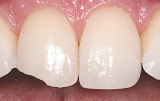 |
|
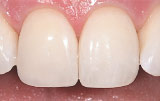 |
|
| Dentistry by Dr. Jeff Brucia | |
Oh James! Before you truly “bond” with your spouse to be, make sure those little chips on your front teeth or broken discolored old fillings are replaced with the latest tooth colored bonding materials. This procedure provides life-like restoration of teeth with “high tech” materials that bond and become part of the teeth themselves while retaining the same light transmitting properties of tooth enamel. You'll never know that they're not yours. This is a same day procedure, but make sure you schedule a dental exam so that your dentist can tell you how much time is needed for a bonding appointment.
- Length of Procedure — depending on the size of surface area that needs to be repaired, expect 45 to 60 minutes per tooth.
- Number of Visits — one visit
- Anesthesia — usually unnecessary but local anesthesia is available on request
- Duration of Results — varies depending on your diet
- Recovery time — none
- Risks — bonding could be damaged during the chewing of hard foods
Veneers
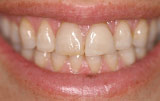 |
|
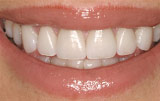 |
|
| Dentistry by Dr. Dean Vafiadis | |
By definition, a veneer is “a thin outer covering, a deceptively attractive outer show.” If necessary let them work for your wedding day smile. This is a great and effective way to change the shape and color of darkened or otherwise unsightly teeth and not for just an hour or a day, but always. Veneers require reducing the outer enamel shell of the teeth and replacing them with glass — like porcelain recreating nature's artistry and giving you exactly the look and color you desire. Allow at least three months for the veneers to be tested in the temporary stage, so that the finals are just right.
- Length of Procedure — depends on the number of teeth needing veneers
- Number of Visits — two to four visits including the examination
- Anesthesia — topical anesthesia or local anesthesia but may not be needed
- Duration of Results — can last 10 to 15 years with proper dental maintenance
- Recovery time — none
- Risks — in rare situations, temporary thermal sensitivity
Crown & Bridge
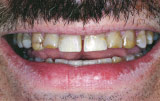 |
|
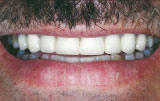 |
|
| Dentistry by Dr. Bruce Weiner | |
A crown or “cap” is generally required when a tooth has been ravaged by decay and is best “restored” by placing a crown. A crown can also be used for cosmetic purposes improving both color and shape. For missing teeth, a bridge may be a little less expensive and possibly more expedient than implants. A bridge includes two abutments (or pillars) to which a false tooth (pontic) is attached. Crown and bridgework looks and functions quite naturally.
- Length of Procedure — 1 to 3 hours depending on the number of teeth involved
- Number of Visits — multiple visits, however plan for 1 to 4 months to be safe
- Anesthesia — usually local anesthetics, but options available include oral or conscious sedation
- Duration of Results — can last on average 10 to 20 years depending on periodontal health and proper maintenance
- Recovery time — minimal
- Risks — slight thermal sensitivity (up to a few weeks)




